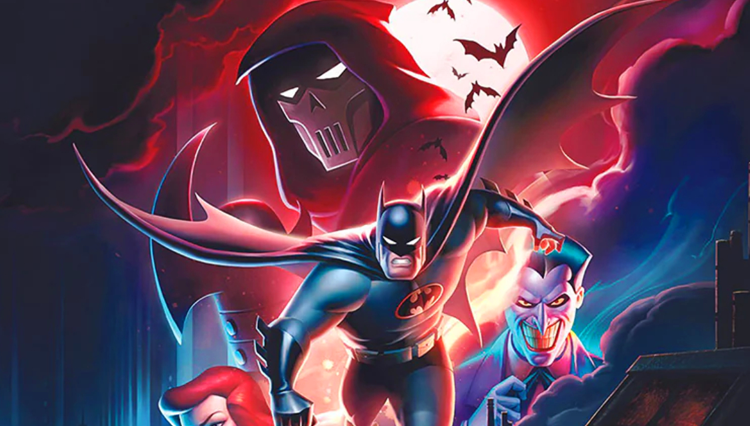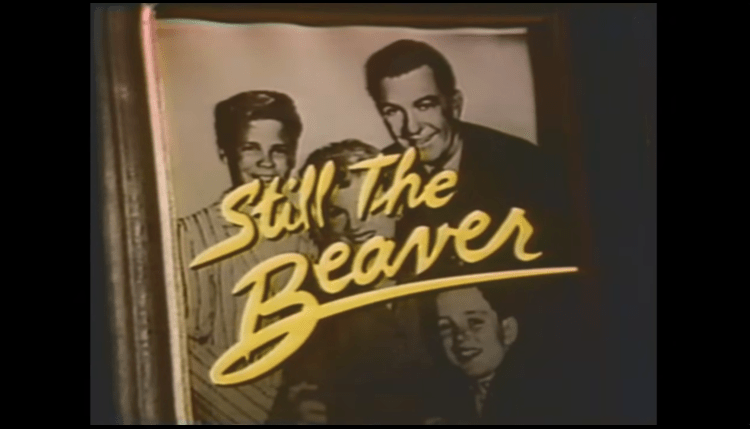
On June 20, 1963, one of America’s favorite family sitcoms left the airwaves after six seasons…except it never really went off the air. For 234 episodes, Leave it to Beaver brought viewers the low-key family life of the Cleavers, with Hugh Beaumont, Barbara Billingsley, Tony Dow, and Jerry Mathers as father Ward, mother June, son Wally, and youngest boy Theodore, who went by the titular nickname “Beaver.”
Few television shows epitomized the prosperous post-war suburban American family (or at least a whitewashed, idealized version of it) as much as LitB. June Cleaver, always in a proper dress and pearls – even at home doing housework – was effectively “America’s Mom.” Ward Cleaver was nearly always in a suit and tie, even lounging at home, and took a briefcase to work at his never-specified office job. At the beginning of the series, Wally was a 13-year-old eighth grader and the nearly 8-year-old Beaver was in 2nd grade, both attending Grant Avenue Grammar School. Episodes typically ended with some type of moral lesson imparted by Ward to one or both boys (he came across most effectively since Beaumont had studied theology and was a lay minister in the Methodist church).
LitB may have been the first TV series to go out of its way to never mention the U.S. state that the show was set in. The fictional Mayfield could have been in any number of midwestern states, but never depicted snowfall, or much in the way of any type of weather other than sunny skies. The trope of ‘Everytown, America’ was picked up by later shows like Green Acres, The Brady Bunch, The Wonder Years, and of course, The Simpsons, where it has become a 35-year running gag.
The series had been created by writers Joe Connelly and Bob Mosher, who based much of the show and its stories on their home life, being the fathers of nine children between them. The pair had been writers for over a decade for The Amos ‘n’ Andy Show and saw it evolve from radio to TV. They also had hands in creating ‘60s series Bringing Up Buddy, Ichabod and Me, Going My Way, The Munsters, and Blondie.
Jerry Mathers had been a child model since the age of 2 and appeared in several 1950s films including Hitchcock’s The Trouble with Harry. At age 8, he was selected out of 277 boys for the part of Beaver in a TV pilot called It’s a Small World, airing in April 1957 as an episode of Studio 57 on CBS. It was picked up as a series for the fall (with some recastings) and Leave it to Beaver debuted in October. While the series was never a big hit during its original run (CBS even famously canceled it after one season, allowing ABC to pick it up for five more), ABC was soon running it in weekday early evening reruns, then weekday mornings. By the end of the ‘60s it had been sold into wide syndication and became a mainstay of TV reruns, airing on some 190 TV stations by the early 1980s. The “and Jerry Mathers as The Beaver” line as heard in the show intro became so iconic over the decades, that it became the name of Mathers’ 1998 memoir.
In January 1982, it began to slip out in the entertainment press that rights holder Universal Studios was working on bringing The Beav back to television. The rumored revival series would have Beaver as a divorced father navigating the modern ‘80s, ostensibly with the help of brother Wally and other original characters. When asked about a revival show, Mathers understood that a TV network was backing a Beaver project but was “having a little trouble with the script. It sounds like a lot of fun. I just hope they get a good script together.” 1
Behind the scenes, it was writer/producer Brian Levant that was the driving force behind the concept of bringing back Beaver, having sold CBS on a reunion TV movie. But even though Still the Beaver did air over a year later in March 1983, things had not gone exactly as planned, as we’ll see.
Still the Beaver 1983 CBS TV Movie
With an opening that very much harked back to the early episodes that began with an opening narration by Hugh Beaumont, we hear the voice of Barbara Billingsley as June Cleaver introducing our story.
“Sometimes it’s hard for me to believe that my boys are grown men. One minute they’re tracking mud through the living room, and then all of a sudden, you’re watching them walk down the aisle. Wally still lives in Mayfield. He’s a successful attorney and dated like one until four years ago when he finally settled down and married his high school sweetheart. No children yet…but they’re working on it. And then, there’s the Beaver. I always figured that living away from home with his wife and family would help Beaver overcome his tendency to be overwhelmed by even the smallest problems…or so I thought.”
We then see Beaver being kicked out of the house by wife Kimberly (Joanna Gleason), suffer the indignity of having the sprinklers come on as he leaves, and taking the bus back to Mayfield (population 18,240) as we hear Supertramp croon Take the Long Way Home.
Does it feel that your life’s become a catastrophe?
Oh, it has to be, for you to grow, boy
When you look through the years and see what you could have been
Oh, what you might have been
If you would have more time
Showing up with a single suitcase wearing his old green baseball cap to his childhood home at 211 Pine Street, he uses the key above the door to let himself into an empty house. The decor has been updated, but it is clearly the same home: same dining room, same kitchen, same upstairs bedroom where Ward Cleaver had imparted fatherly wisdom all those years ago. But a montage of memories ending with a tombstone lets us know that things aren’t the same anymore. However, soon June Cleaver arrives home and scolds Beaver for drinking out of the milk bottle, just like old times.
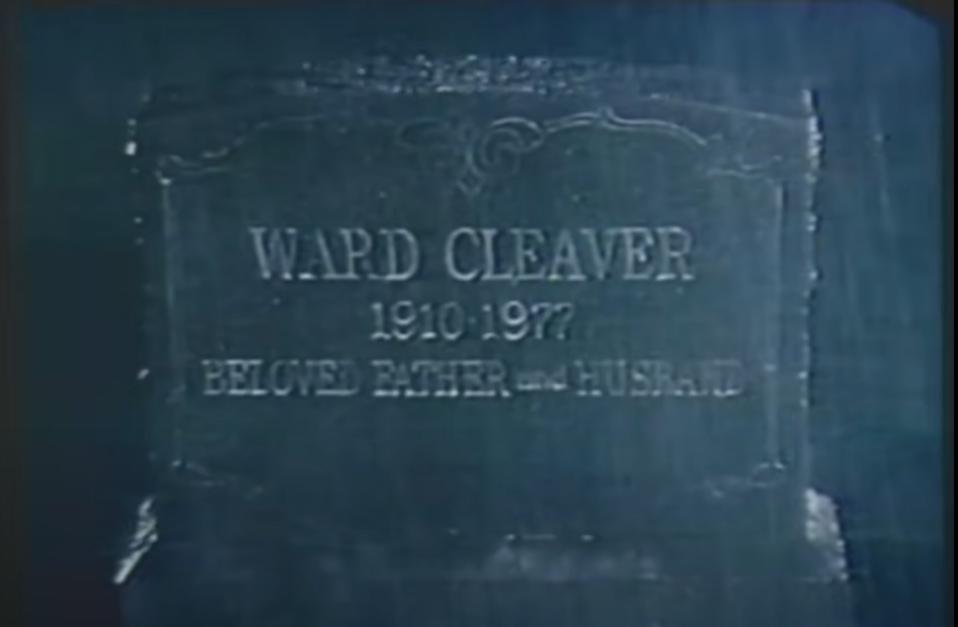
We also catch up with Wally, who happens to be chasing Eddie Haskell (Ken Osmond) around a construction site before punching him in the gut over the botched foundation job on his new house. While Eddie makes good on the repairs, this necessitates Wally and wife Mary Ellen (Janice Kent, replacing Pamela Baird) also staying at the Cleaver house for much of the telefilm. Later in their boyhood room, the brothers reminisce about the old days before being brought back down to earth with Wally’s offer to help with Beaver’s seemingly inevitable battle with Kimberly in divorce court.
“Wally, when did life get so tough?” “I think it all started when the Yankees traded Roger Maris.”
Things pick up a bit when we are introduced to the new Cleaver boys: Corey (Corey Feldman), a cynical 11-year-old, and Oliver (John Snee), an 8-year-old going through a superhero phase (like Hollywood for the past 20 years). When picking them up for a day at the zoo, Kimberly is quick to point out that Ollie’s mask and cape were an ‘expression of his hostility’ toward his father. Wow.
Beaver’s friends Larry and Richard also make appearances; Richard (Rich Correll) now a pop psychologist and Larry (Rusty Stevens), having converted to an Eastern religion, wears a turban, and goes by the name Vishnu. Catching up with them at the malt shop, the previously aimless Beaver comes to the decision to pursue custody of his boys. Boyhood friend Whitey (Ed Begley Jr., replacing Stanley Fafara), now a corporate headhunter, gets him placed at Ward’s old company – under none other than Fred Rutherford (Richard Deacon), now the boss. This makes Wally’s old friend, DeLorean-driving dork Lumpy (Frank Bank), his coworker.
Things take another turn when Kimberly shows up with the announcement that she is going to Italy to pursue veterinary school and that Beaver can have custody of the boys. This makes for a full house as Beaver moves them (in his impulsively purchased ‘65 Mustang) to Mayfield (right into the old room) as well as creates friction between Wally and Beaver regarding fathering techniques. Meanwhile, Wally and Mary Ellen have their own problems as they continue to try for a baby.
The rest of the telefilm gives us vignettes of boyhood mischief as Ollie with new friend Marcus breaks Corey’s guitar, Corey and Eddie Haskell, Jr (Ken Osmond’s son Eric in a bit of inspired casting) graffiti the gym wall, and Corey and Ollie run away from home. Along the way, we see Tooey (Tiger ‘Luke’ Fafara) and even Miss Canfield (Diane Brewster), now the principal of Grant Avenue School. Finally, June downsizes to a condominium and sells the house to Beaver, and Mary Ellen has given birth to baby Ward, setting the stage for a potential series.
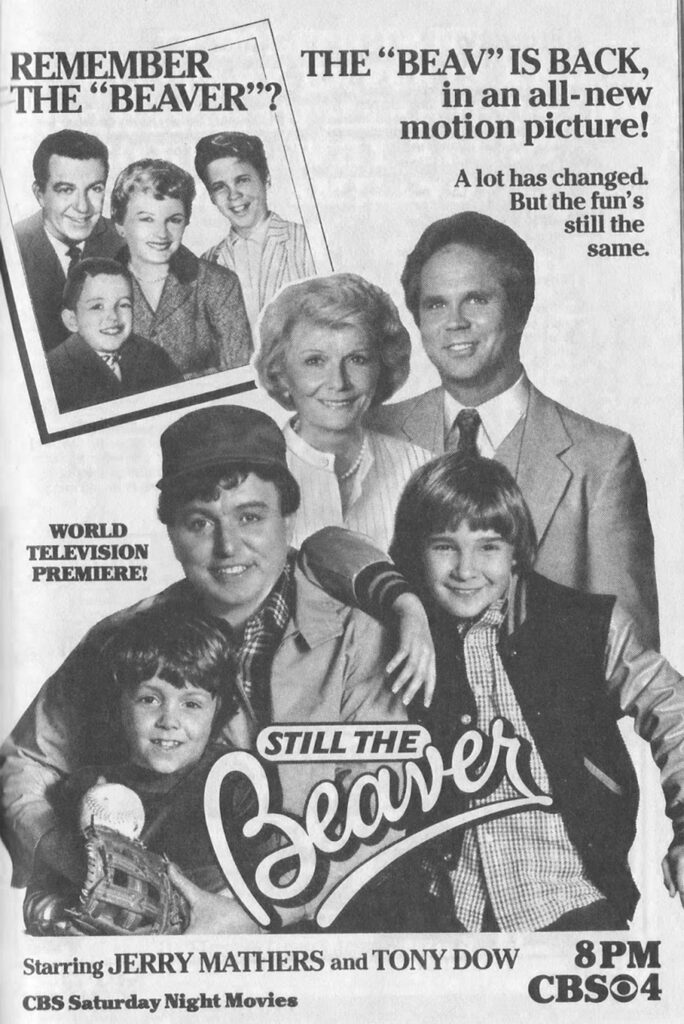
Thoughts on the Telefilm
From the very beginning, Still the Beaver let us know we weren’t in the 1950s anymore. From being literally fired by his offscreen father-in-law (there goes the company car), kicked out by the wife (figuratively being fired as a husband) to Beaver letting himself into an empty house like a then modern-day latchkey kid, our characters were thrust into the 1980s. Wally’s insinuated impotence and Kimberly’s choice to ‘find herself’ resulting in Beaver becoming a single parent gives us a further gut punch of ‘80s reality, much like the one Wally dispensed to Eddie early in the film.
The plot point of Kimberly leaving for Italy to study veterinary medicine seems completely out of left field. Although this is presented as a ‘temporary’ arrangement, in reality this is a minimum of a four-year course of study, provided she already had a four-year degree in a related science. Hardly a situation that would last just for “a little while.”
The telefilm leans into the original schtick of not naming the state where the fictional Mayfield is located. June’s personalized license plate “NO 1 MOM” is registered in the “American Homeland.” A neat little detail for those paying attention. Also, Lumpy’s DeLorean was actually Frank Bank’s own car.
According to the headstone shown, family patriarch Ward Cleaver had died in 1977, meaning June had been a widow for some six years prior to the events of the film. In reality, Hugh Beaumont had died in May of the prior year, just as the script was being finalized. The telefilm suffers greatly from the lack of his presence as compared to the original series where his benevolent guidance was at the heart of the stories told. Another criticism noted by several reviewers was the infantilization of the main character, now a 33-year-old father, but still somehow also the same bumbling boy in the green cap viewers had loved for the past 25 years. We’re left to interpret Beaver and Kimberly’s marital problems as stemming from his inability to grow up and take charge, although specifics were kept somewhat vague. Mathers’ acting was also somewhat rough after a 20-year break and all involved would have benefited from the additional rehearsal time, which was built into the budget but not utilized by the director, according to Brian Levant. Newspaper reviews of the telefilm were largely negative at the time.
The inclusion of popular music by Supertramp and Simon & Garfunkel might surprise viewers. Take the Long Way Home is played over the opening credits, which according to composer Roger Hodgson “is a vehicle for reflection in which the sometimes-disappointing realities in our grown-up lives can reflect in a not-so-positive way on the hopeful idealism of our youth…the deeper meaning to this song is about taking the long way home to our true home, that place of real connection inside our heart.”
Simon & Garfunkel’s At the Zoo accompanies Beaver, Corey, and Ollie’s zoo visit; but that song also carried a deeper meaning as a metaphor of the different aspects of human character. However, it was Supertramp’s The Logical Song heard while Beaver, Richard, and Larry catch up at the malt shop that seemed written for Beaver’s existential crisis (and likely that of more than a few viewers).
When I was young, it seemed that life was so wonderful
A miracle, oh, it was beautiful, magical
And all the birds in the trees, well, they’d be singing so happily
Oh, joyfully, oh, playfully watching me
But then they sent me away to teach me how to be sensible
Logical, oh, responsible, practical
And then they showed me a world where I could be so dependable
Oh, clinical, oh, intellectual, cynical
There are times when all the world’s asleep
The questions run too deep
For such a simple man
Won’t you please, please tell me what we’ve learned?
I know it sounds absurd
Please tell me who I am…
BEHIND THE SCENES and Revival Series
Filmed in October 1982, Still the Beaver aired on March 19, 1983, as a CBS Saturday Night Movie, against NBC comedies Mamas Family/Teachers Only followed by newsmagazine Monitor, and ABC’s dependable offering of The Love Boat/Fantasy Island. The reunion telefilm was well received, handily winning the evening with an 18.9 Neilsen rating and a 33 share, and was the second highest-rated movie of the week for 1983. The director was Steven Hilliard Stern, who brought us other TV movies such as Mazes and Monsters (1982), Not Quite Human (1987), and Breaking the Surface: The Greg Louganis Story (1997), as well as the occasional theatrical release such as The Devil and Max Devlin (1981).
Of course, Still the Beaver showing up on our TV screens in 1983 was not something that arose out of a vacuum. Jerry Mathers had pitched all three broadcast networks a Beaver reunion show circa 1973, 10 years after the original ended its run – but all had turned him down, saying it wouldn’t work. 2 But since that time, the networks had discovered the appeal of TV revival movies based on old sitcoms. After all, they had built-in audiences quite familiar with the originals that had been rerun for years. The Father Knows Best Reunion aired on CBS in 1977. The following year, the castaways were saved in Rescue from Gilligan’s Island on NBC, which had triggered two more reunion TV movies. Return of the Beverly Hillbillies had also been done on CBS in 1981. And of course, there was The Brady Girls Get Married on NBC in 1981, a reunion movie split into TV episodes at the last minute and airing as The Brady Brides. Perhaps a Beaver reunion was inevitable. But it took the efforts of one particular fan turned industry professional to make it happen.
While watching reruns of the original series in the late 1960s, Brian Levant had pondered over what Wally and the Beav would be up to in the years after the show had ended. When he grew up and first moved to Los Angeles in 1975 to work in television, that seed of an idea was codified on his personal written list of projects he wanted to work on: Still the Beaver. But first, he had to pay his dues as a TV writer, working on episodes of The Jeffersons, Brothers and Sisters, The Bad News Bears, and especially Happy Days.
On the set of that long-running ABC sitcom, he met associate producer Nick Abdo whose contacts were crucial to being able to eventually pitch his Still the Beaver concept to CBS, the network that had originally broadcast the first season of Leave it to Beaver. According to Levant, after trying to get in a room with CBS execs for some three and a half years, he ‘blew it’ and CBS wasn’t impressed with him…although they were evidently interested in the project, as they chose to go forward with it without him.
Engaging other screenwriters, CBS wasn’t happy with the script they had turned in and called Levant back to rewrite it. Working furiously and knowing the source material well, Levant rewrote the script in 11 days. One key decision would be how to include the character of Ward Cleaver, with Hugh Beaumont in very poor health at the time. “We knew he was very ill and was not going to be able to do very much. But we did have him in the script,” said Nick Abdo in 1982, who collaborated with Levant on the story. Their concept was to film black-and-white flashbacks showing Ward at Beaver’s graduation, wedding, and diapering his first child. They had also decided the story would depict the death of the Cleaver patriarch. However, a few days before the rewrite was turned into CBS, Hugh Beaumont passed away at the age of 72, necessitating a change to Levant and Abdo’s story. Beaumont would now be seen only in flashback, with the character of Ward having passed away several years prior.
Although their story was produced, Abdo expressed an overall disappointment in the entire experience with CBS, as he recapped for Jerry Buck in 1984. “It was two years before we got the go-ahead for a movie on CBS. Then they wouldn’t let Brian write it. They gave it to another team of writers, and we got a script you couldn’t shoot. We started from scratch, then they forced a director on us who made a depressing movie. Let’s say the movie wasn’t up to our expectations.” 3
Even though the CBS telefilm performed well, that network wasn’t interested in doing a revival TV series. However, seeing the series’ potential, another longtime Beaver fan was there to help. Young Universal exec Ned Nalle was 9 years old when ABC canceled the original series in 1963. Five years before the famed letter-writing campaign to save Star Trek, the lad had taken it upon himself to write a letter of protest to “Mr. ABC” regarding the Beaver cancellation. Twenty years later and now a junior executive at Universal’s Pay TV division, Nalle was instrumental in pitching a revival series based on Still the Beaver to the newly launched Disney Channel. The premium cable network ordered 13 episodes with an option for an additional 13. With a schedule suited to cable and not broadcast television, new episodes would be run every two weeks and were run six to eight times during each period. The show debuted on November 7, 1984, and 26 new episodes ran through December 4, 1985.
The series presented Beaver in a better light than the telefilm, as a responsible single parent, having traded in his Mustang for a minivan to drive the school carpool, and working the same unspecified office job his father did. Eventually, Beaver and Lumpy strike out on their own and start their own firm. A couple of changes were made for the series, which included retconning two of the kids. The character of older brother Corey became Kip, with an age jump of about two years (played by Kipp Marcus, 14). Instead of baby Ward, Wally and Mary Ellen had a grade school-age girl named Kelly (Kaleena Kiff, turning 10 during the first season). Eddie Haskell’s son, seen briefly in the TV film, is also a regular character but now named Freddie (again played by Eric Osmond, turning 13 during the first season). June Cleaver was again living at the family home along with Beaver’s clan, with no mention of the condo she was moving to at the end of the telefilm.
The plot point of Wally and Mary Ellen’s new site-built home went away, and the family was now inexplicably living next door to the Cleaver house at 213 Pine Street. Yes, the classic Colonial Street with its fully appointed houses and yards on the Universal backlot was just as much a character of the revival series as any of the actors. Unlike most sitcoms where a static exterior shot of a house is used to establish where the following interior scene takes place, characters would often be seen in the yard, entering/exiting houses, walking or driving down the street, and engaging in neighborhood activities.
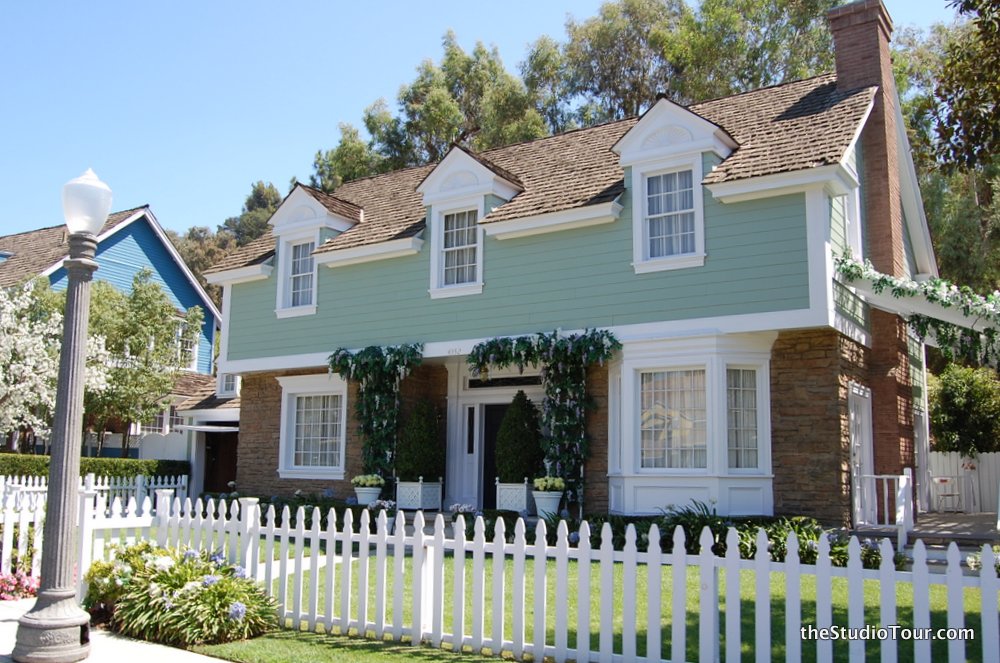
The “Cleaver house” had originally been built for the 1955 Humphrey Bogart movie Desperate Hours before being utilized as the Cleaver home for seasons 3-6 of the original show, after production moved from Republic Studios to Universal. It was then used for a variety of productions after the original Beaver ended, including Marcus Welby, M.D., which saw the front appearance significantly altered to become the home office of the title character. The original appearance was restored for the Still the Beaver telefilm, though its location on the backlot street was moved. Following the TV series run, the facade was modified again for the Tom Hanks film The Burbs (1989). The house Wally’s family occupied next door is called the “Dana house” by the studio, as it was occupied by Professor Dana and his daughters in the 1941 film Nice Girl? The house has also been seen in Bedtime for Bonzo (1951) and The Thrill of it All (1963). Longtime fans may recognize what would become the famous “Munster house” is also located on this backlot street, three houses down from the Cleavers, seen in numerous episodes.
The detailed history of the backlot ‘houses’ (which are only facades without fully built interiors) is more complex than the brief overview I present here, but the original Cleaver house was moved to a mostly unused portion of the backlot following the series, and was reportedly torn down sometime in 2022. A new construction recreating the Cleaver house was built for the 1997 theatrical Leave it to Beaver film. This version of the house was left standing and has been seen on Desperate Housewives; it is also the one currently seen on the Universal Studios backlot tram tour.
In addition to the classic Beaver actors, Janice Kent was brought over from the Still the Beaver movie as Mary Ellen Rogers-Cleaver. She had previously been seen in the short-lived series The Ted Knight Show and about a dozen other roles. After being told about the telefilm casting, she auditioned on a Thursday and started filming on Monday, nixing her plans to move back to the East Coast. During the series, she was able to try her hand at directing a couple of episodes. Today, she keeps busy as an acting and life coach.
Kipp Marcus, who had been appearing in Oliver! on Broadway, had grown up watching reruns of the original series. When he saw a casting call ad for Still the Beaver, he knew he wanted the role and asked his manager to get him an audition. After being cast, he moved from Connecticut to LA and lived with producer Brian Levant for the first two seasons of the show. During these years, Marcus grew up around actors like Ron Howard and Henry Winkler, who were friends of the Levants. In interviews, Marcus has recalled Winkler helping him with his geometry homework, and Universal exec Ned Nalle writing his letter of recommendation for NYU’s Tisch School for the Arts. The character name of Kip was a nickname, and the character’s proper first name was Ward, an homage to Hugh Beaumont’s original series character. These days, Kipp has five of his own kids and has worked as an executive for Amazon and Nike.
John Snee’s character of Oliver was carried over from the telefilm. In addition to Still the Beaver, he had appeared in a few TV movies prior to the series as well as the lead role of Julian, the 7-year-old boy dying of leukemia in the tearjerker Forever and Beyond, filmed in 1981 but never receiving a domestic theatrical release. By all reports he was initially a little cutup on set and was often partners in crime with Kaleena Kiff and Eric Osmond, roaming the Universal backlot during downtime. He once was called out for goofing off during a scene by Ken Osmond, and recalls his parents nearly pulled him off the show after the second season due to his increasingly arrogant attitude at home because of his perceived stardom. Discussing this with Brian Levant led to his father Dennis Snee being brought on as a staff writer/producer, with his presence on the lot a short jaunt away in the writer’s bungalows being a constructive influence on the young actor. Following the series, John appeared in the 1990 NBC TV movie Camp Cucamonga. Afterwards, John left acting and now works in property management in the L.A. area. He also has five kids…(something in the water at Universal?)
This was Kaleena Kiff’s second series, having previously been a regular on the NBC series Love, Sidney prior to her Beaver role. Kaleena recalls one early episode that co-starred Chad Allen where she was getting sick, but the episode revolved around her character, and she tried to power through. However, it turned out she had pneumonia and production had to shut down while she recovered. Later, the writers integrated her equestrian interests into the character, and she ended up buying the horse she rode in a season 4 episode, moving him from Florida to L.A. when the series concluded. Kaleena later co-founded boutique production company Curiosity Pictures and currently lives in Canada with her husband and daughter.
Eric Osmond, son of Ken Osmond, had to audition against other actors to reprise the role of Freddie for the series. He was of course given the part, being a natural at recreating that old Eddie Haskell chuckle and ability to give Kip and Ollie ‘the business.’ Following the series, Eric attended film school at USC, spending summers interning with Brian Levant. He became a film editor, not only working on Levant projects like The Flintstones in Viva Rock Vegas and Scooby-Doo live-action films, but also on megahits Thor, Captain America: The First Avenger, and most recently The Super Mario Bros. Movie.
Later in the series, Ken Osmond’s younger son Christian also joined the cast in a recurring role as Freddie’s brother ‘Bomber.’ At the beginning of the third season, there is an age jump for Wally and Mary Ellen’s son Kevin, who was previously a baby but now appeared to be about 5, played by Troy Davidson.
The series also saw the return of Veronica Cartwright as Violet Rutherford, Cheryl Holdridge as Julie Foster, Tiger Fafara as Tooey, Richard Correll as Richard, Diane Brewster as Miss Canfield, Jeri Weil as Beaver’s nemesis Judy Hensler, and even Pamela Baird was given a walk-on role. Among the many guest stars were some who were young and became well-known actors later in life such as Nicole Eggert, Giovanni Ribisi, Chad Allen, Shannen Doherty, Jack Black, Brian Austin Green, and Joaquin Phoenix.

Still the Beaver was one of the most popular programs on The Disney Channel, watched by over half of channel subscribers, and the show was used in subscription campaigns to lure in more viewers. However, over the course of that successful run, the Disney company (under new CEO Michael Eisner and new president Frank Wells) had reevaluated its partnership with Universal. While previously Disney took a sort of a ‘rising tide lifts all boats’ attitude toward new area tourist attractions, the new company execs began to see Universal’s plans for an Orlando-area working studio theme park as a threat to their dominant position there.
In February 1985, Eisner announced plans for their new Disney-MGM Studios, which bore more than a striking resemblance to those for what would be called Universal Studios Florida. Disney’s “Catastrophe Canyon” for example, would feature a tram tour interrupted by an earthquake and flash flood; which seemed to copy elements of Universal’s planned “Hollywood Canyon” adventure tram ride. 4 The move infuriated execs at Universal, and tensions escalated from there. Poor Beaver was caught in the crossfire, and in May, Disney canceled the popular series.
Charles Engel (who ran Universal Pay Television) immediately announced his intention to shop the show to other networks, while Disney clapped back, saying another network couldn’t air the show until they were done with repeating the episodes through most of 1986. The studio saber rattling threatened any future of the show since the actors playing the new Cleaver children were at critical ages where they would rapidly age out of the roles if a year went by between seasons. When viewers next saw them, Kip might be taller than the Beav with a voice deeper than Uncle Wally, and Ollie would be in junior high. Realizing this, Ned Nalle convinced Universal to continue production of the show and finance a new run of 13 episodes even before a buyer was found.
Fortunately, Ted Turner came to the rescue, and how! Turner Broadcasting ordered an unprecedented 74 episodes of the series, which would fittingly take the show to the end of the 1980s as Kip graduates high school and Ollie and Kelly finish junior high in sort of a repeat of how the original series ended. For these seasons, the series opening was revised, the music theme changed, and the show was retitled The New Leave it to Beaver.
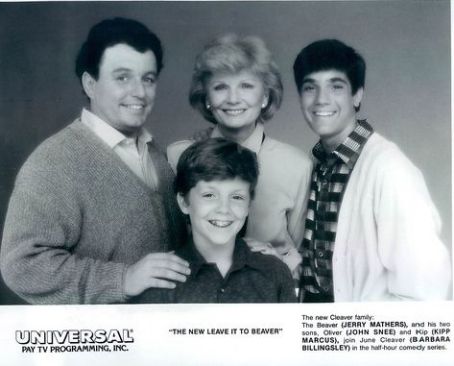
The original Still the Beaver music theme, a slightly jazzed-up rendition of the original, ran two full minutes. Its synthesizer, guitar riffs, and whistling were true to the spirit of the original and were arranged and performed by the talented Walter Murphy. Subsequent seasons strayed further from the original, first revamped with a much more generic, ‘80s saxophone sound, then finally leaning into acapella doowop. Fun fact: the original Beaver theme was called Toy Parade and composed by David Kahn, Melvyn Leonard, and Mort Greene for the show. Although a 1958 Golden Record had contained a vocal version of the theme, and the sheet music was commercially available which included the lyrics, it seems that like other famous TV themes such as Star Trek, Bonanza, and The Munsters, the fact that there were lyrics to Toy Parade was not widely known for some years. When writer John Javna was doing research for his book, he was surprised to find the existence of the lyrics, which he included in The TV Theme Song Sing-along Songbook, released in 1985. The following year, they were performed on screen for the first time as Wally sang the song to new baby Kevin in a Nov 1986 episode of The New Leave it to Beaver.
For the final season of production, the show packed up and moved (literally) to Universal’s Orlando studios, becoming the first regular TV series to be produced there. House exteriors were recreated and interior sets reassembled on Stage 21. To inaugurate the Orlando production, an all-American pancake breakfast was served to the news media, after which Jerry Mathers ceremoniously nailed the “211” house number to the doorpost, and the media was invited to stay and watch the day’s filming.
Brian Levant branched out into directing on the revival series and went on to direct 90s favorites Beethoven, The Flintstones, and Jingle All the Way. He is a huge pop culture collector and his massive collections can be seen in his 2022 coffee table book My Life and Toys. Nick Abdo also directed episodes of NLitB and was involved in producing ‘80s films The Flamingo Kid, Nothing in Common, Overboard, and Beaches. More recently, he has supervised the production of hits Bad Santa (2003) and The Last House on the Left (2009) and currently offers film consultant and financing services to independent filmmakers.
Ned Nalle became president of Universal Worldwide Television, where he oversaw the development and sales of all the studio’s syndicated movies and TV shows. From there, he was nabbed by Playboy to oversee programming content for its 40-odd TV networks and media outlets. He has served as a consultant for ION Television, developing original drama series for their prime-time schedule. He now has his own film distribution company, Copper Beeches Inc., which manages the distribution rights to the Billy Jack films as well as its own original productions.
Why hasn’t the TV movie Still the Beaver or the subsequent series had any kind of a modern release? While it’s true the inclusion of popular music in the telefilm may complicate a release due to the requirement of obtaining music clearances, other factors may be at play here. We know Universal Studios notably had a fire in 2008, destroying buildings including the one they called the Video Vault (building 6197) where videotapes and film reels of films and TV shows were stored. Some 40-50,000 videotapes were destroyed in the fire by Universal’s own estimate at the time; some of which may have existed only on videotape. Fans have attempted to nail down whether Still the Beaver/New Leave it to Beaver tapes were among those lost, but Universal has never confirmed this, nor ever publicly announced just what has been lost. (A 2019 expose by the New York Times revealed this was far more than Universal has ever admitted to, for it turns out building 6197 was also the West Coast storehouse for the Universal Music Group. The loss of over 100,000 original master recordings for artists like Bing Crosby, Buddy Holly, Elton John, the Eagles, and Bill Haley & the Comets makes this disaster likely the biggest loss of recorded media in history.) 5
However, it turns out a bizarre and murky rights issue may hover over Still the Beaver/New Leave it to Beaver. In 1987, MCA/Universal decided it was no longer going to finance show production. Enter Australian-owned Qintex Entertainment, who agreed to finance the production as part of a $50 million deal, obtaining the syndication rights to StB/NLitB as well other Universal shows they wanted to colorize: McHale’s Navy, The Munsters, and the original Leave it to Beaver. This would take StB/NLitB to over 100 episodes, a notable total which would make it a much better syndication offering.
Two years later, parent company Qintex Australia attempted to merge with MCA/Universal in a $1.5 billion deal, but when they were unable to fulfill this arrangement, MCA/Universal sued them for breach of contract. Qintex incredibly also attempted to buy MGM Studios from Kirk Kerkorian in a separate $1.5 billion deal this same year, but the overextended Qintex was unable to make this happen either. Meanwhile, U.S. division Qintex Entertainment (part or full owners of Colorization, Inc. and Hal Roach Studios) were finding film/TV colorization both more expensive and not as profitable as expected and entered Chapter 11 bankruptcy in late 1989. In the wake of this, in January 1990 Qintex agreed to return syndication and colorization rights to the above-mentioned series to MCA/Universal.
To add to this saga, Australian Qintex majority owner Christopher Skase (known for his lavish lifestyle spending) arranged a $13.5 million payment to a private company he owned before gaining board approval. When this was reported to the Australian Securities Commission, creditors moved in and the company financially collapsed. Skase was criminally charged, but fled the country, becoming an international fugitive. Found in Spain, the Australian government spent much of the 1990s building their criminal case and attempting to extradite him, while he reportedly lived in luxury. Just before it seemed he would be deported from Spain and face Australian courts, Skase died of stomach cancer. The bizarre story is covered in the 2000 satire Let’s Get Skase.
Even though the rights to the original LitB were returned to Universal, the status of StB/NLitB is not quite as clear. To review the studios involved: Qintex (originally called Halcyon Studios) became RHI Entertainment (who brought you The Hallmark Channel) in the wake of the Qintex financial implosion, was renamed Sonar Entertainment, and now again goes by the original Halcyon name. It is owned by parent company Chicken Soup for the Soul Entertainment, which also owns Redbox and internet streamer Crackle. (Insert confused math lady meme here. Also, while this article was being finalized, Chicken Soup for the Soul Entertainment filed for Chapter 11 bankruptcy protection.)
Entertainment industry writer Scott Hettrick, who has written about the series since 1988, has investigated the rights issues for years and spoken to executives at all involved studios, including Universal. Unfortunately, he reports in a Facebook fan group “they have no awareness or interest or knowledge if they own/have rights to New Leave it to Beaver, and not enough curiosity to even look into it.” Until someone first spends the time and effort to find if master copies of series episodes still exist, then the money to wade through any legal ownership issues, The New Leave it to Beaver is one of the many TV series of past decades without a legitimate modern release.
Fortunately, Hettrick spent two years finding the best available home recordings, most from his personal Betamax tapes, and digitizing/editing them for our enjoyment. All 101 episodes can be seen on his YouTube channel, along with the 1983 Still the Beaver telefilm and other Beaver video goodies. Fans still discuss the revival series on the Facebook group The New Leave it to Beaver/Still The Beaver Fan Page. I’d like to thank Scott Hettrick for his years of work preserving and chronicling information about the series, as well as Bryon Nelson Jr, Nick Bailey, and the Fancounters/Help! I’m Turning Into My Dad! podcast for their numerous Stb/NLitB interviews, where many of the details in this article originated.
Forgotten TV Movies is a column that considers made-for-TV movies of the 70s/80s of various genres. Oh, the places we’ll go and the sights we’ll see.



